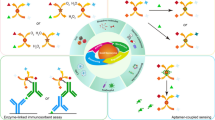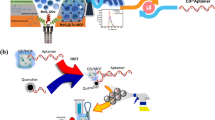Abstract
An ultrasensitive electrochemical biosensor is described for the determination of microRNAs. It is based on the use of DNA-templated copper nanoparticles (Cu NPs) as signalling probe. MicroRNA-222 was selected as the model analyte. The probe was obtained from two different oligonucleotides (containing complementary bases) via hybridization chain reaction to form long DNA concatemers as template. The Cu NPs were formed by reaction of ascorbate with copper sulfate. The biosensor was fabricated as follows: (a) Capture probe (cDNA) with a thiolated group was immobilized on reduced graphene oxide modified with gold nanoparticles (rGO/Au NPs), (b) materials was placed on a glassy carbon electrode (GCE); (c) the modified electrode (cDNA/rGO/Au NPs/GCE) was sequentially hybridized with microRNA-222 and signal probe; this results in the formation of a sandwich structure of cDNA-microRNA-signal probe on surface of the modified electrode. Differential pulse voltammetry was employed to record the electrochemical response of biosensor in pH 6.0 solution. As a result, a sensitive oxidation current with a peak potential at 0.10 V (vs. SCE) was obtained corresponding to Cu NPs. The experimental conditions were optimized. Under optimal conditions, the biosensor exhibited wide linear response range (0.5 fM to 70 nM) and low limit of detection (0.03 fM; at S/N = 3). The assay possesses high selectivity and can discriminate analyte microRNA from single-base mismatched microRNA.

A sensitive electrochemical biosensor is described for the determination of microRNA-222 by using a dsDNA-templated Cu NPs as signalling probe. (A) represents the preparation of signal probe, and (B) represents the fabrication of electrochemical microRNA sensor.






Similar content being viewed by others

References
Png KJ, Halberg N, Yoshida M, Tavazoie SF (2012) A microRNA regulon that mediates endothelial recruitment and metastasis by cancer cells. Nature 481:190–194
Meng XD, Zhang K, Dai WH, Cao Y, Yang F, Dong HF, Zhang XJ (2018) Multiplex microRNA imaging in living cells using DNA-capped-au assembled hydrogels. Chem Sci 9:7419–7425
Volinia S, Calin GA, Liu CG, Ambs S, Cimmion A, Petrocca F, Visone R, Iorio M, Roldo C, Ferracin M, Prueitt RL, Yanaihara N, Lanza G, Scarpa A, Vecchione A, Negrini M, Harris CC, Croce CM (2006) A microRNA expression signature of human solid tumors defines cancer gene targets. Proc Natl Acad Sci U S A 103:2257–2261
Wang F, Zheng Z, Guo J, Ding X (2010) Correlation and quantitation of microRNA aberrant expression in tissues and sera from patients with breast tumor. Gynecol Oncol 119:586–593
Degliangeli F, Kshirsagar P, Brunetti V, Pompa PP, Fiammengo R (2014) Absolute and direct microRNA quantification using DNA–gold nanoparticle probes. J Am Chem Soc 136:2264–2267
Zhang CZ, Han L, Zhang AL, Fu YC, Yue X, Wang GX, Jia ZF, Pu PY, Zhang QY, Kang CS (2010) MicroRNA-221 and microRNA-222 regulate gastric carcinoma cell proliferation and radioresistance by targeting PTEN. BMC Cancer 10:367–377
Kilic T, Erdem A, Ozsoz M, Carrara S (2018) microRNA biosensors: opportunities and challenges among conventional and commercially available techniques. Biosens Bioelectron 99:525–546
Yang L, Liu CH, Ren W, Li ZP (2012) Graphene surface-anchored fluorescence sensor for sensitive detection of microRNA coupled with enzyme-free signal amplification of hybridization chain reaction. ACS Appl Mater Interfaces 4:6450–6453
Zhang YL, Li ZP, Cheng YQ, Lv XC (2009) Colorimetric detection of microRNA and RNase H activity in homogeneous solution with cationic polythiophene derivative. Chem Commun 22:3172–3174
Fang SP, Lee HJ, Wark AW, Corn RM (2006) Attomole microarray detection of microRNAs by nanoparticle-amplified SPR imaging measurements of surface polyadenylation reactions. J Am Chem Soc 128:14044–14046
Gao ZQ, Yu YH (2007) A microRNA biosensor based on direct chemical ligation and electrochemically amplified detection. Sensors Actuators B Chem 121:552–559
Zouari M, Campuzano S, Pingarrón JM, Raouafi N (2017) Competitive RNA-RNA hybridization-based integrated nanostructured-disposable electrode for highly sensitive determination of microRNAs in cancer cells. Biosens Bioelectron 91:40–45
Shuai HL, Huang KJ, Xing LL, Chen YX (2016) Ultrasensitive electrochemical sensing platform for microRNA based on tungsten oxide-graphene composites coupling with catalyzed hairpin assembly target recycling and enzyme signal amplification. Biosens Bioelectron 86:337–345
Wang ZY, Si L, Bao JC, Dai ZH (2015) A reusable microRNA sensor based on the electrocatalytic property of heteroduplex-templated copper nanoclusters. Chem Commun 51:6305–6307
Wang YH, Huang KJ, Wu X, Ma YY, Song DL, Du CY, Chang SH (2018) Ultrasensitive supersandwich-type biosensor for enzyme-free amplified microRNA detection based on N-doped graphene/au nanoparticles and hemin/G-quadruplexes. J Mater Chem B 6:2134–2142
Xia N, Zhang LP, Wang GF, Feng QQ, Liu L (2013) Label-free and sensitive strategy for microRNAs detection based on the formation of boronate ester bonds and the dual-amplification of gold nanoparticles. Biosens Bioelectron 47:461–466
Liao YH, Huang R, Ma ZK, Wu YX, Zhou XM, Xiung D (2014) Target-triggered enzyme-free amplification strategy for sensitive detection of microRNA in tumor cells and tissues. Anal Chem 86:4596–4604
Lv WF, Zhao JM, Situ B, Li B, Ma W, Liu JM, Wu ZX, Wang W, Yan XH, Zheng L (2016) A target-triggered dual amplification strategy for sensitive detection of microRNA. Biosens Bioelectron 83:250–255
Hu TX, Zhang L, Wen W, Zhang XH, Wang SF (2016) Enzyme catalytic amplification of microRNA-155 detection with graphene quantum dot-based electrochemical biosensor. Biosens Bioelectron 77:451–456
Wu XY, Chai YQ, Yuan R, Zhuo Y, Chen Y (2014) Dual signal amplification strategy for enzyme-free electrochemical detection of microRNAs. Sens. Actuators B 203:296–302
Chen YX, Huang KJ, Niu KX (2018) Recent advances in signal amplification strategy based on oligonucleotide and nanomaterials for microRNA detection a review. Biosens Bioelectron 99:612–624
Wang YH, He LL, Huang KJ, Chen YX, Wang SY, Liu ZH, Li D (2019) Recent advances in nanomaterial-based electrochemical and optical sensing platforms for microRNA assays. Analyst 144:2849–2866
Miao P, Tang YG, Yin J (2015) MicroRNA detection based on analyte triggered nanoparticle localization on a tetrahedral DNA modified electrode followed by hybridization chain reaction dual amplification. Chem Commun 51:15603–15740
Ge ZL, Lin MH, Wang P, Pei H, Yan J, Shi JY, Huang Q, He DN, Fan CH, Zuo XL (2014) Hybridization chain reaction amplification of microRNA detection with a tetrahedral DNA nanostructure-based electrochemical biosensor. Anal Chem 86:2124–2130
Liu HY, Bei XQ, Xia QT, Fu Y, Zhang S, Liu MC, Fan K, Zhang MZ, Yang Y (2016) Enzyme-free electrochemical detection of microRNA-21 using immobilized hairpin probes and a target-triggered hybridization chain reaction amplification strategy. Microchim Acta 183:297–304
Rotaru A, Dutta S, Jentzsch E, Gothelf K, Mokhir A (2010) Selective dsDNA-templated formation of copper nanoparticles in solution. Angew Chem Int Ed Eng 49:5665–5667
Zhou Z, Du Y, Dong S (2011) Double strand DNA-templated formation of copper nanoparticles as fluorescent probe for label-free aptamer sensor. Anal Chem 83:5122–5127
Xu FZ, Shi H, He XX, Wang KM, He DG, Guo QP, Qing ZH, Yan LA, Ye XS, Li D, Tang JL (2014) Concatemeric dsDNA-templated copper nanoparticles strategy with improved sensitivity and stability based on rolling circle replication and its application in microRNA detection. Anal Chem 86:6976–6982
Zhang JJ, Zhang WJ, Guo JJ, Wang JC, Zhang YZ (2017) Electrochemical detection of C-reactive protein using copper nanoparticles and hybridization chain reaction amplifying signal. Anal Biochem 539:1–7
Qing TP, Zhang KW, Qing ZH, Wang X, Long CC, Zhang P, Hu HZ, Bo F (2019) Recent progress in copper nanocluster-based fluorescent probing: a review. Microchim Acta 186:670–690. https://doi.org/10.1007/s00604-019-3747-4
Wang J, Shi AQ, Fang X, Han XW, Zhang YZ (2014) Ultrasensitive electrochemical supersandwich DNA biosensorusing a glassy carbon electrode modified with gold particle deco-rated sheets of graphene oxide. Microchim Acta 181:935–940
Wang MG, Shen B, Yuan R, Cheng W, Xu HB, Ding SJ (2015) An electrochemical biosensor for highly sensitive determination of microRNA based on enzymatic and molecular beacon mediated strand displacement amplification. J. Electroanal Chem 756:147–152
Bettazzi F, Asl EH, Esposito CL, Quintavalle C, Formisano N, Laschi S, Catuogno S, Marrazza MIG, Mascini M, Cerchia L, Franciscis VD, Condorelli G, Palchetti I (2013) Electrochemical detection of microRNA-222 by use of a magnetic bead-based bioassay. Anal Bioanal Chem 405:1025–1034
Bharti A, Agnihotri N, Prabhakar N (2019) A voltammetric hybridization assay for microRNA-21 using carboxylated graphene oxide decorated with gold-platinum bimetallic nanoparticles. Microchim Acta 186:185–196. https://doi.org/10.1007/s00604-019-3302-3
Wang F, Chu Y, Ai Y, Chen L, Gao F (2019) Graphene oxide with in-situ grown prussian blue as an electrochemical probe for microRNA-122. Microchim Acta 186:116–125. https://doi.org/10.1007/s00604-018-3204-9
Liu LL, Chang Y, Xia N, Peng PZ, Zhang LP, Jiang MG, Zhang JB, Liu L (2017) Simple, sensitive and label-free electrochemical detection of microRNAs based on the in situ formation of silver nanoparticles aggregates for signal amplification. Biosens Bioelectron 94:235–242
Acknowledgements
This work was financially supported by the National Natural Science Foundation of China (No. 20675002).
Author information
Authors and Affiliations
Corresponding author
Additional information
Publisher’s note
Springer Nature remains neutral with regard to jurisdictional claims in published maps and institutional affiliations.
Electronic supplementary material
ESM 1
(DOCX 654 kb)
Rights and permissions
About this article
Cite this article
Wang, Y., Meng, W., Chen, X. et al. DNA-templated copper nanoparticles as signalling probe for electrochemical determination of microRNA-222. Microchim Acta 187, 4 (2020). https://doi.org/10.1007/s00604-019-4011-7
Received:
Accepted:
Published:
DOI: https://doi.org/10.1007/s00604-019-4011-7



